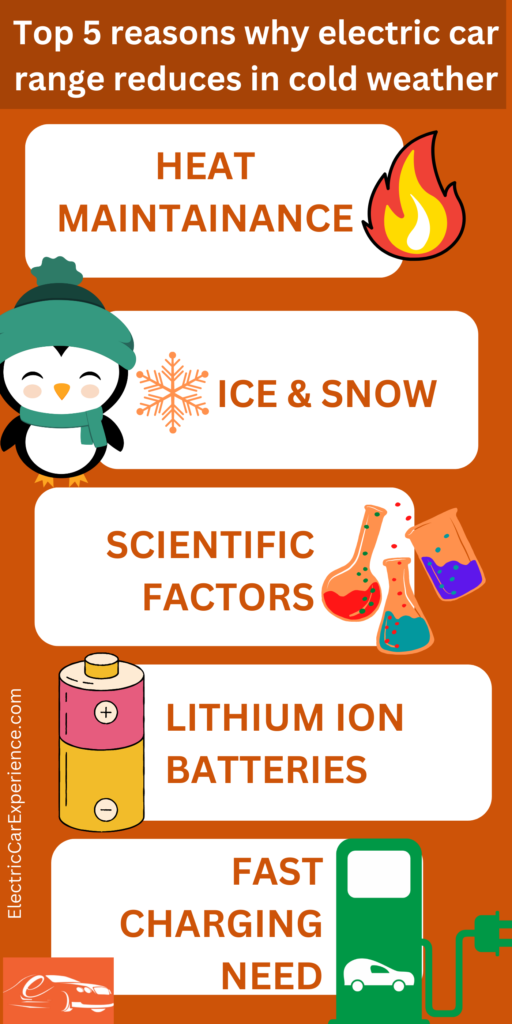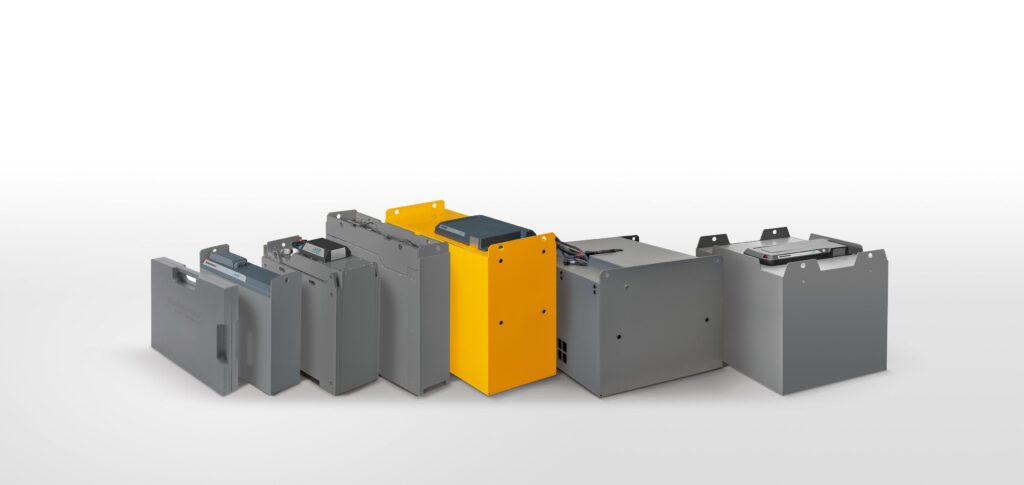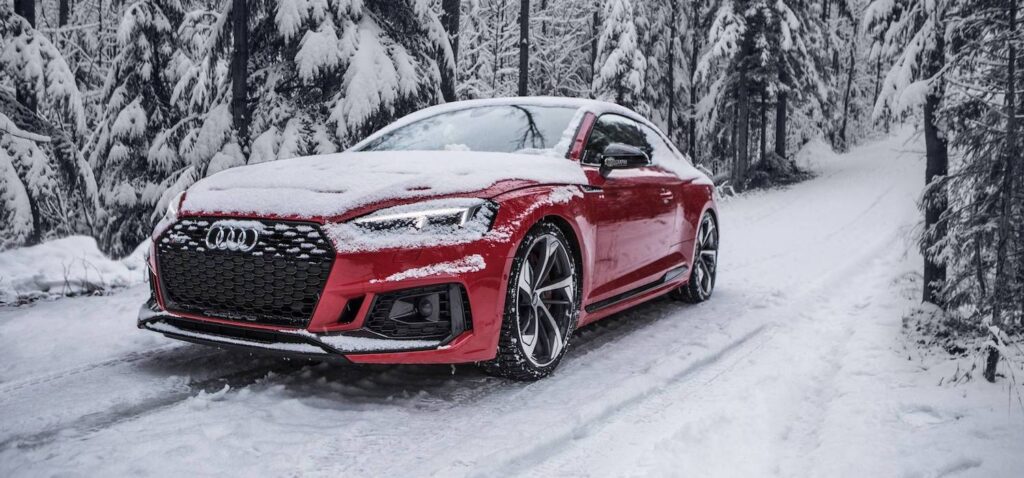
Numerous variables, including the type of electric car and its range in fair weather, affect the amount of range lost. According to a AAA study, when the heater is turned up in cold weather, electric vehicles (EVs) can lose up to 41% of their range. Why the range of electric cars decreases in cold weather
Electric cars range reduce in cold weather 5 reasons.
- Heat Maintenance
- Ice & Snow
- Scientific Factor
- Lithium Ion Batteries
- Fast Charging Need
In cold climates, many factors affect the electric car range. Let’s see them one by one.
[toc]

- Heating.
The battery discharges more quickly in the winter since it is harder to keep the car’s interior at a suitable temperature. The electric motor and the heating system must both be powered simultaneously by the car’s battery.
Although purchasing a car with a long-range battery can address this issue, doing so influences the car’s weight, structure, and design. The size of the battery must therefore be balanced with the overall design of the vehicle by car manufacturers.
With air-source heat pumps, electric vehicles (EVs) require substantially less energy to heat the interior.
- Ice and snow.

Two more elements that can shorten an electric car’s range are snow and slick roads. Like any other car, if you lose traction, your wheels will spin.
Tire slippage can lower your vehicle’s range and is negative for fuel economy. We strongly advise leaving traction control on when operating an EV in the winter to prevent severe wheel spinning.
The same is true while driving in deep snow and utilizing winter tires, which are frequently heavier than summer tires. The car must consume more battery power as a result of the greater resistance.
- A bit of science.
Even preconditioned electric vehicles will have a limited range in severely cold temperatures. There is often a significant loss of range (between 20 and 35%) when temperatures drop below 5°C. Extreme cold, or below -10°C, makes things substantially worse.
For instance, a Chevrolet Bolt EV with an expected range of about 415 kilometers in summer temperatures will have its range reduced to 250 kilometers in really cold weather, even with the heat off.
Perhaps not so simple, but once put in layman’s terms, it’s still easy to comprehend. When assessing a battery’s efficiency, it is essential to consider its capacity to convert chemical energy into electrical energy.
To generate electricity, electrons must “swim” in a liquid or gel electrolyte. At decreasing temperatures, the solution (electrolyte) becomes thicker and denser, making it harder for the electrons to move around.
As a result of the electrons requiring more energy to move, battery performance diminishes.
This process is very similar to exercising outside in the cold. Your body needs the energy to stay warm, so you have less endurance than you would in the summer. The battery loses strength and life as it is used up.
As a result, it makes it reasonable that electric cars have a shorter range in the winter, just as it is expected for drivers of gasoline vehicles to use more fuel as the weather becomes colder.
- Lithium-ion batteries.

Along with supplemental heating, the effect of cold weather on Li-Ion batteries also contributes to a reduction in the range of EVs. As the temperature drops, the physical and chemical interactions, particularly conductivity and diffusivity, slow down.
As a result, the batteries’ impedance has increased (longer charging times), and their range has decreased.
However, these chemistry changes to the battery are just transitory. As the temperature rises, the impacts will be the opposite.
- The Danger of fast charging stations.
Due to the reduced battery range in cold weather, owners might feel the need to often use fast-charging locations. Some EV producers have also developed their quick-charging technology.
Even while these rapid stations are great for swiftly charging your car, if you use them too frequently, the battery may be harmed. Heat damage may be caused by a battery’s increased resistance.
Therefore, the best course of action to prevent running out of battery life is to always remember to keep the battery attached.
The first consideration when considering an electric vehicle purchase is the vehicle’s range. Most customers are worried about how far they can go on one full charge because there aren’t many Electric Vehicle (EV) charging facilities in various places. But why electric car range reduce in cold weather?
As the temperature decreases, your car’s performance efficiency will decline. When driven in temperatures below -40°F (-40°C), an electric car’s driving range can be reduced by up to 40%. This will only get worse when the temperature drops.
Additionally, the weather may have an impact on this selection of electric automobiles.
We are aware that electric vehicles function in cold climates, but what about extremely cold climates?
Especially when you take into account that there are locations in the USA where it may be as cold as -30 °F (-34 °C).
If the driving temperature directly affects how well an electric car performs, you may anticipate that as you go to colder places, its performance will deteriorate. So, is that the case?

What is the reality regarding electric vehicles and the cold? Are electric automobiles affected by the cold? What effects does the cold have on electric automobiles, if any?
Continue reading this article to find the answers to all of these queries.
How to Prevent Your Electric Car from Tanking in the Winter?
While the bulk of automotive experts and media concentrate on how the winter affects regular gasoline vehicles, very few of them pay attention to how to keep your electric vehicles. Sadly, this makes it challenging for many DIY enthusiasts to maintain their vehicles throughout the winter and prevent major issues.
Keep your electric car garaged when not in use to help shield it from the elements. Cover your car all overnight: Vehicle covers may be able to help you lock in some of the heat and protect your vehicle from ice, and there are more preventions.
Let’s look more closely at what experts in the field of automobiles suggest for winterizing electric vehicles:
- Use Eco Mode.
The majority of EVs offer an eco mode that lowers power use to increase mileage. By limiting the energy supply to the driving motor and cabin warmers, the battery’s performance in cold weather is maximized.
Additionally, most electric vehicles accelerate a little bit slower in eco mode since less power is delivered to the motor. This can improve your driving safety by reducing the likelihood of wheel spins on slippery or snowy roadways.
- Prevent sudden stops and starts.
Contrary to popular belief, smoother driving might help you conserve battery.
If you can reduce fast pauses and starts, your battery will last longer.
If you need to make several stops, plan your route. Try to find routes that will allow you to avoid traffic as well.
- Parking.
If at all possible, keep the battery warm by parking your electric car in a heated area. The battery will need less energy to warm up when you begin your subsequent journey.
- Regenerative braking.
Through the utilization of energy storage during braking and extended periods of significant deceleration, this feature enables you to lower your car’s electricity use regardless of the weather.
In some EVs, the regenerative braking feature can be tuned, enabling you to use the brakes more firmly than you would under more benign circumstances.
- Warm up your car first.
Heat your car in advance before leaving. The majority of EVs include apps that let owners turn on their vehicle’s heating system from a mobile device.
The cabin warms the battery, potentially improving its overall performance in the cold. Additionally, your battery charge won’t be reduced if you keep heating your car while plugged in.
- Charge ahead of time.
Make sure to plan and end your charge as close to your leaving time as you can. Additionally, your car’s battery management system will save about 15–20% capacity when it’s extremely cold outside to heat the battery.
Try to keep its battery over 20% to avoid battery degradation in cold climates.
- Turn on the heated seats.
Using your heating system to stay warm in ice circumstances seems obvious, no doubt. However, your range will be higher the less energy you waste. To stay warm while using less electricity, use the heated seats and/or steering wheel in your automobile.
- Keep your tires inflated.
The air in your tires contracts when the temperature drops, lowering their air pressure. The tire pressure decreases by one pound per square inch for every 10 degrees that the air temperature drops (PSI).
According to one study, the proper pressure can boost your car’s energy efficiency by 3% to 7%.
Make sure to regularly check the tire pressure to get the most out of your winter driving range. It’s also a good idea to swap your summer tires for winter ones if you live somewhere where it snows frequently.
- Drive slower.
People prefer to drive more slowly in chilly climates. Speed helps to increase range since it makes the battery deplete more quickly. Additionally, considering the icy road conditions, you and your passengers should avoid any accidents.
Winter Range Loss for the Popular Electric Car Model.
In comparison to their WLTP-estimated range, electric vehicles with heating systems saw an average seasonal range reduction of roughly 25%.
Here, we list a few electric car models that experience range loss during the winter and compare the anticipated range loss%.
We got this information from here
The table displays the projected range reduction for each electric vehicle in cold conditions.
| Electric Car Model | EPA Range1% | EPA Range2% | Estimated Loss Range% |
|---|---|---|---|
| Audi e-Tron | 92 | 100 | -8 |
| BMW i3 | 72 | 96 | -24 |
| Chevy Bolt | 64 | 96 | -32 |
| Chevy Volt | 67 | 98 | -31 |
| Ford Mustang Mach-E | 64 | 92 | -28 |
| Hyundai Kona | 92 | 111 | -19 |
| Jaguar I-pace | 100 | 103 | -3 |
| Nissan Leaf | 100 | 114 | -14 |
| Tesla Model 3 | 101 | 102 | -1 |
| Tesla Model 5 | 100 | 104 | -4 |
| Tesla Model X | 99 | 99 | 0 |
| Tesla Model Y | 104 | 103 | +1 |
| VW e-Golf | 85 | 108 | -23 |
What can I do to Prevent Decreased Charging Rates During the Winter?
In winter, the temperature of the electric vehicle gets reduced. And you need to charge your vehicle quickly. It is necessary to keep your electric car charging.
You must manage EV battery performance in the winter because consumers of EVs will likely experience slower charging times and a shorter driving range.
Performance management strategies for EV batteries exist.
So, here are some suggestions for controlling how the EV battery operates.
- Preheat the battery.
Several EV models offer the option for drivers to preheat the battery before starting the car or while an route to a fast-charging station.
Thus, power won’t be diverted from charging and the battery will receive priority heating until it reaches operating temperature. We strongly recommend preheating the batteries if your EV model supports it.
- Wait to charge.
If you are unable to warm up your EV’s batteries before a trip, we advise waiting as long as your car will allow before carrying out a charge. Because the battery has time to at least get lukewarm, charging proceeds more quickly and is better for the battery.
Regeneration might also be a wise choice to speed up battery heating. Furthermore, rapid acceleration can assist raise the temperature – but obviously, we don’t want to promote reckless driving!
- Park the car indoors.
Of course, not everyone will be fortunate enough to be able to do this, but if you have the opportunity, we’d strongly advise keeping your EV somewhere warmer. This will help you save electricity while heating the batteries and keep them from getting too cold.
When you’re not home if at all feasible, keep your car in a garage or another building. If you park your car indoors, the battery will last longer because maintaining a temperature takes less energy than raising it.
- Apply wax before winter.
One of the biggest problems with EVs has been minor dings and dents that can take months to fix for some types and models due to the dearth of body shops that specialize in specialized vehicles.
Before applying The car should be waxed when the temperature is between 60 and 80 degrees. You must make sure that the car’s surface is impeccably clean before applying the wax.
One of the most popular products on the market is Shine Armor Fortify Quick Coat. This spray performs admirably on a variety of surfaces.
Which Electric Vehicles are Ideal for Winter Driving?

Every electric car reduces its temperature during winter. But for a better experience of driving some of the electric cars are ideal and solve the problem of driving in winter.
Snowy conditions can make driving a misery. Snowfall affects transportation, and it’s typical to witness automobiles sliding backward down hills and randomly abandoned vehicles parading down ordinarily busy streets.
Avoid driving in the snow, is the first piece of advice you’ll hear from experts. You have duties, though, so you can’t hibernate inside your house all winter long. The next best thing to do is to invest in an automobile that can handle snow well.
There are now several EV options on the market that can function in harsh winter weather because the majority of manufacturers are kind people.
Therefore, we’ve listed some of the top electric vehicles here that are built to function effectively in cold climates.
The table illustrates how cold weather reduces an electric car’s range.
| Electric Car Model | Min Range (in winter) | Max Range( in summer) | Loss in Range |
|---|---|---|---|
| Rivian R1T & R1S | 260 miles | 400 miles | 35% |
| Tesla Model 3 | 114 miles | 205 miles | 44.4% |
| 2023 Subaru Solterra | 222 miles | 228 miles | 2.63% |
| Mercedes Benz EQC | Not mentioned | 255 miles | – |
| Audi E-Tron Quattro | 205 miles | 209 miles | 1.91% |
| BMW iX | Not mentioned | 380 miles | – |
| Jaguar I-Pace BEV | Not mentioned | 292 miles | – |
| Ford Mustang Mach-E | 335 miles | 379 miles | 11.60% |
| Polestar 2 Arctic Circle EV | Not mentioned | 270 miles | – |
Conclusion
In cold conditions, the battery range can be drastically reduced. EVs are more difficult to control on slick roads, much like all other vehicles. Nevertheless, even in freezing conditions, electric vehicles continue to run flawlessly.
The top 10 causes of electric car range reduction in cold weather are covered here. further indicated winter electric car prevention measures. Additionally, we listed a few of the top electric vehicles that excel in cold climates.
FAQs.
What is the best weather for electric cars?
A 70°F temperature and the absence of precipitation are ideal for an electric car battery. However, if the temperature exceeds -21°F or 95°F, many electric cars’ range will be reduced by more than a third. Even sophisticated electric vehicles with battery cooling devices lose charge in hot and cold weather.
Can you charge an electric car in rain and snow?
The risk of charging a car in the rain and snow may worry new owners. However, there is no need to be concerned because the supplied charging cables can be used outside in both rain and shine. Once extension cords are involved, things start to get complicated because they could not be approved for outdoor use.
How much less range does electric cars have on WLTP?
The association’s initial finding was that the tested EVs had roughly an 18.5 percent shorter range than what their makers claimed on WLTP. The Opel Ampera-e, which you might be more familiar with as the Chevy Bolt, was the poorest vehicle in the category.
It was only able to travel 296.9 km, or 29.81 percent less, than the WLTP range of 423 km.
What is the biggest winter EV range test ever?
NAF, or the Norwegian Automobile Federation, decided to test 20 EVs. The scale of that winter EV range test was probably unprecedented.
To accommodate the cars with longer ranges, the evaluation expanded the route from Oslo to Hafjell from 200 km (124 miles) to 482 km (300 miles).
Post related to electric cars.
- BMW x5 xdrive40e Tax Credit 2024
- Electric Car Range At 70Mph, 80Mph, 90Mph, and 100Mph (Different Range)- Guide 2024
- Tucker Carlson Electric Cars
- How Do You Reset The Range On A Tesla?
- Is it true that you’re damaging your electric car battery if you let it get below 20%?-An ultimate guide 2024
- Can We Use an Ordinary Car Battery to Power Up Electric Car?
- Top 10 reasons why Tesla Wants to Start Refining Lithium in Texas- An ultimate guide 2024
- Top 10 ways to increase the lifespan of an electric car battery- A complete guide 2024
- electric car battery theft
- Can You Power Your House With Used Electric Car Batteries? If So, Is The Off-Grid System Created From Those Batteries Legal?-An Ultimate guide 2024
- Do Electric Cars Use a Lot of Electricity?
- Chevy Bolt Range | What Is The Range Of Chevy Bolt? – 2024 Guide
- Average Electric Car Battery Replacement Cost
- Is It Okay to Charge Your Electric Car Before it Runs Out of Charge?
- Top 15 best affordable electric cars in the U.S.
